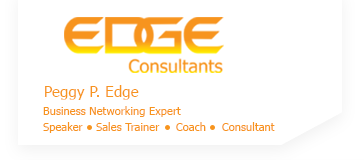Networking: Conveying your Who-What-Why
When you give your 30-Second Commercial at a networking event, do you just stand up, open your mouth and hope the right words to come out? You are shooting yourself in the foot unless you plan in advance what you are going to say. Developing a good elevator speech requires some forethought.
A well-crafted commercial will answer 3 questions: Who, What, and Why.
- Who are your clients or prospects? Be specific with the levels of management that you call on as well as the industry niche that you work within or are expecting to break into. Example: I work with______________.
- What the products and services that you offer? Highlight only 1 product or service at a time. Remember you only have 30-seconds. Example: I provide ________.
- Why should I listen to what you have to say? Your Value Proposition explains why your product or service is important. Example: Because or So that_________.
To improve your presentation, write the answer to all of these questions and fill in the blank. Next, get in front of a mirror and practice-practice-practice.

Peggy P. Edge (c) 2014
Networking: Last Quarter Coasting or Scrambling
As we embark on the last quarter of the year, what are your plans for your business? Are you beginning to coast because you’ve already met quota? Or…are you scrambling to network so you can finish the year on top?
If you are coasting, don’t do that. Your competition is nipping at your heels. Start working on next year’s plan.
If you are in scrambling mode, take a deep breath, re-group and tweak your plan. Some of the things you can do to tweak your plan include:
- Make sure you have identified everyone in your Connection Circle. Think about any group that you have become involved in for the first time this year. How well are you connected? Reach out and connect on a personal level.
- Look at your Inactive Client list. Touch base and ask for a new opportunity to work with them.
- Dust off that pile of business cards on your desk from events you have attended and enter them in your contacts. Drop them a note and your business card in the mail as a reminder of who you are and what you do. Ask them what you can do for them.
- Call existing clients to thank them for their business. Ask them if they know anyone they can refer to you. Be bold and ask for a personal introduction.
- Above all——Don’t be afraid to ask.
Now go out Make Connections – Seize Opportunities.
Peggy P. Edge (c) 2014
Networking – Dale Carnegie style
Dale Carnegie was the consummate networker. He wrote “How to Win Friends and Influence People” in 1936! His teachings are still as relevant today as they were when originally written.
Here are 3 excerpts from his book that we can apply when attending your next networking event:
- “Become genuinely interested in other people.” The moral here is to drop the “what’s in it for me” attitude. When you engage others and ask them about what they do, why there are there or simply welcome them as a guest, you show that you care about them.
- “Smile.” You certainly cannot win many friends if you always go around with a frown on your face.
- “Be a good listener. Encourage others to talk about themselves.” Many times at networking functions, I see folks spending all of their time talking about themselves and trying to establish their place whereas if they would be a sponge and soak up what other people have to say, they would be much more effective in making an impression.
Dale Carnegie was a genius at teaching folks how to be winners in all aspects of life. His writings are still very applicable today as they were almost 80 years ago.
Source: http://en.wikipedia.org/wiki/How_to_Win_Friends_and_Influence_People
Peggy P. Edge (c) 2014


